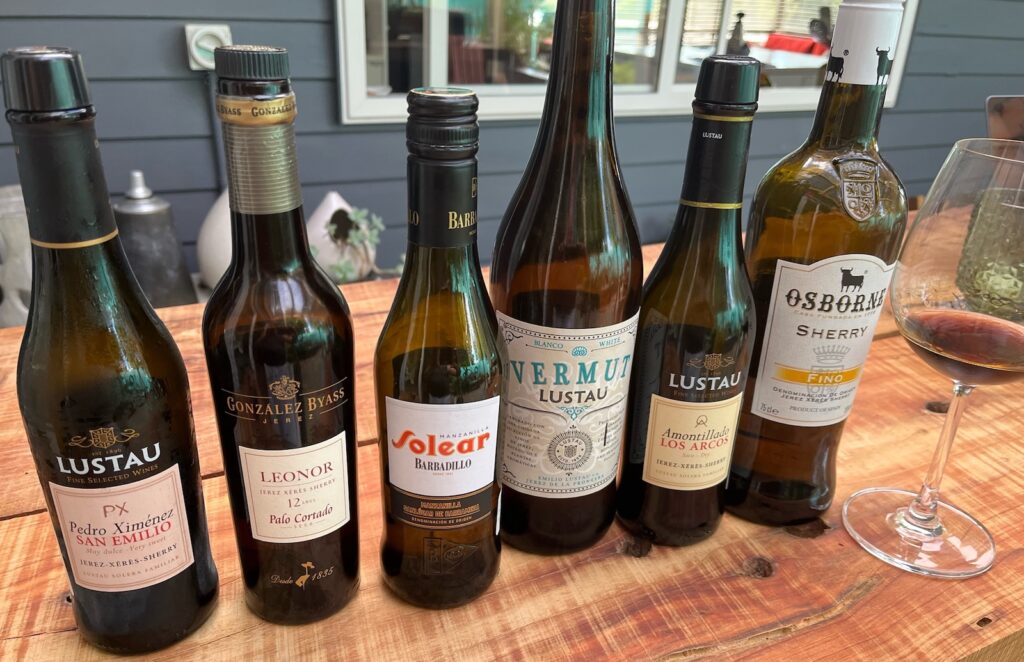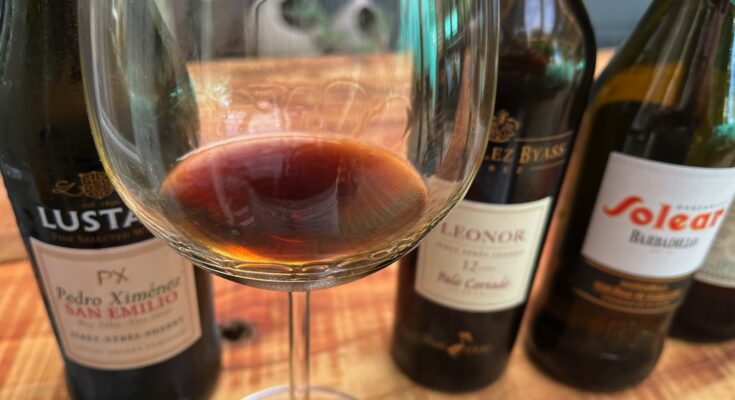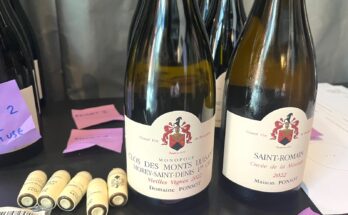Sherry is a fortified wine, principally made from white Palomino grapes in Andalusia, Spain – centred around the city of Jerez. Made in a variety of styles, ranging from light, fresh expressions that aren’t too far away from a white table wines, through to darker and richer styles that have been allowed to oxidise as they age. Very sweet dessert wines are also created using Pedro Ximénez and Moscatel grapes.
After the wine used a base for sherry has finished fermentation, it is fortified with grape spirit to increase the final alcohol content. Wines intended for the drier, lighter styles of fino and manzanilla are fortified to an alcohol content of 15.5 percent by volume. Wines intended to be aged longer – creating the oloroso and amontillado styles – are fortified to reach an alcohol content of at least 17 percent.
As they age in a barrel, they develop a layer of ‘flor’ which is a yeast-like growth that helps protect the wine from oxygen, and subsequent oxidation. The wines with a higher alcohol level don’t develop flor, and will deliberately oxidise slightly as they age, giving them a darker colour. The ‘flor’ is what gives the sherry the signature taste, contributing yeasty flavours to the finished wine. Depending on the wine, it may be aged completely under the layer of flor to produce a fino or manzanilla sherry. It has been found that the higher levels of fortification limits the growth of flor, and those wines will therefore undergo oxidation ending up as an amontillado or oloroso style of sherry.
An article I read online describes the process as this – “During the fermentation phase of sherry production, the flor yeast works anaerobically, converting sugar into ethanol. When all the sugar has been consumed, the physiology of the yeast changes to where it begins an aerobic process of breaking down and converting the acids into other compounds such as acetaldehyde. A waxy coating appears on the cells’ exterior, causing the yeast to float to the surface and form a protective blanket thick enough to shield the wine from oxygen”.

No particular reason is required to open a few bottles of sherry, but as a rather good wine to go with food – it did seem appropriate to make sure that we had a few ‘tapas’ on hand to taste alongside. At the lighter, drier end of the sherry spectrum, the wines are just superb to have with a meal – or as appetisers certainly. My preference is for the Manzanilla and Fino styles at the dry side of these Spanish wines – where the ‘flor’ influence is so fresh and yeasty.
Four wines were opened for this tasting initially – and then a couple of ‘extras’ also appeared – one of which was a Vermouth, so not technically a sherry – but more on that later! Starting from the driest…
Barbadillo Solear Manzanilla
The largest producer of Manzanilla in the region. This dry, zesty sherry is one from the coastal region of Sanlúcar de Barrameda, which are famous for their briney, salty character. The saltiness here is quite subtle – with a delicate almond meal note on the nose. A dried rose petal, pot-pourri character and floral (not flor) edge right through the palate, into a creamy texture. The finish is brilliant – tangy and long. 92pts
Osborne Fino
Again, like the Manzanilla – not an expensive wine…sherries are super value and under-rated in price. With a green olive character and texture – and, again, a lovely briney saltiness. Very dry and jazzy, dancing across the palate. Almond croissant, citrus, fresh hay. Finishes pithy and drying. 91pts
Lustau ‘Los Arcos’ Amontillado A little ‘hot’ in the mouth – alcohol and acidity combining, but still a very dry expression. A mid-amber colour. Tar, sumac, tangerine, charred capsicum and roast walnut on the palate. Rich, nutty with a sourdough toast note at the finish. 91pts
Gonzalez Byas ‘Leonor’ Palo Cortado A mid-mahogany brown in the glass, with a nougat, cashew, walnut and toasty oak depth to the nose. Plush, smooth and with a good weight to the palate, but still quite dry. Good ‘rancio’ notes (from 12yrs ageing) and golden fruit flavours – blood orange, apricot and dried pineapple. The finish is lengthy, dry and luxuriant. 93pts
After these wines, we got right into the swing of it and opened a bottle of Lustau Vermut, and San Emilio Pedro Ximénez. The PX I already reviewed here – https://winefolio.co.nz/?p=7504 at 94pts. The Vermouth was really good too – white – made by blending a fino sherry and a sweet and floral Moscatel wine. It is dry and crisp, yet has a floral edge to the nose and hints of sweetness and minerality into the palate. Really herbal, with a delicious bitterness that I love in white wines, but comes through so bravely and pure in this Vermouth. Gentian, Wormwood and Chamomile all contribute to this. Just fab. 93pts
Three items were plated to accompany the short ‘flight’ of sherries – raw oysters, dressed with cracked black pepper, lemon juice and lemon zest. Then a small pile of white anchovies – with sesame oil, pepper and lime – and my personal requirement for having with sherry – almonds and cashew nuts that had been given an extra dry roasting in a pan with sea salt, aleppo pepper and a sprinkle of olive oil.




